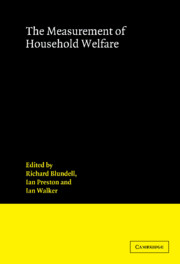Book contents
- Frontmatter
- Contents
- List of contributors
- 1 An introduction to applied welfare analysis
- 2 Measuring the cost of children: a theoretical framework
- 3 The collective approach to household behaviour
- 4 Ordinal and cardinal utility: an integration of the two dimensions of the welfare concept
- 5 The determination of welfare in nonintact families
- 6 Female labour supply, housework and family welfare
- 7 Engel equivalence scales in Sri Lanka: exactness, specification, measurement error
- 8 Measuring the life-cycle consumption costs of children
- 9 Family fortunes in the 1970s and 1980s
- 10 Ethically-consistent welfare prescriptions are reference price-independent
- 11 The effect of systematic misperception of income on the subjective poverty line
- Index of names
- Index of subjects
6 - Female labour supply, housework and family welfare
Published online by Cambridge University Press: 13 January 2010
- Frontmatter
- Contents
- List of contributors
- 1 An introduction to applied welfare analysis
- 2 Measuring the cost of children: a theoretical framework
- 3 The collective approach to household behaviour
- 4 Ordinal and cardinal utility: an integration of the two dimensions of the welfare concept
- 5 The determination of welfare in nonintact families
- 6 Female labour supply, housework and family welfare
- 7 Engel equivalence scales in Sri Lanka: exactness, specification, measurement error
- 8 Measuring the life-cycle consumption costs of children
- 9 Family fortunes in the 1970s and 1980s
- 10 Ethically-consistent welfare prescriptions are reference price-independent
- 11 The effect of systematic misperception of income on the subjective poverty line
- Index of names
- Index of subjects
Summary
Introduction
The use of observed income and expenditure variables as measures of welfare has a long tradition in studies of taxation and inequality. An objection to the practice is that the variables omit the contribution of nonmarket time. With the increasing availability of household datasets attention has focused on the estimation of labour supply models for the purpose of making welfare comparisons based on a utility function defined on consumption and leisure, with leisure measured as nonmarket time. The approach has been used extensively for analysing reforms to the taxation of married couples. Examples include Arrufat and Zabalza (1986), Blundell et al. (1986, 1988), Zabalza and Arrufat (1988) and Symons and Walker (1990). An obvious criticism of the approach is that the nonmarket activities of married women do not easily fit the conventional notion of ‘leisure’. Much of their time is spent on housework, producing goods and services for which there are substitutes in the market place, and so it may be more appropriate to treat domestic activity in the same way as market activity, as suggested by Becker (1965).
A long-standing and central concern in the taxation of families is that of horizontal equity in the treatment of those with different time allocations to household production and market work. Conflicting interpretations of what the criterion implies for policy typically reflect different weightings on household production in the calculation of the welfare indicator used to assess the distributional merits of a particular reform.
- Type
- Chapter
- Information
- The Measurement of Household Welfare , pp. 140 - 163Publisher: Cambridge University PressPrint publication year: 1994
- 4
- Cited by



